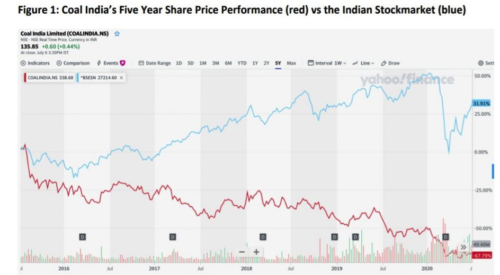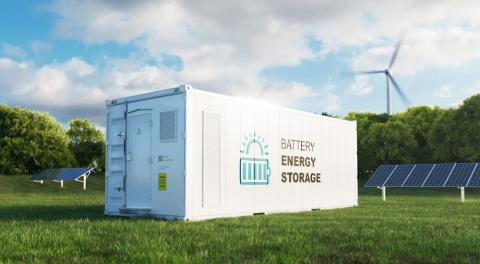Coal India’s valuation eroding under climate transition risk
At approximately 70% of generation, coal is the dominant fuel for electricity (or power) in India.[1] Further, in India, most coal (again, approximately 70%) is used for power generation.[2] Due to various reasons; including coal’s historic cost-competitiveness, energy security, incumbency and ability to provide baseload power; many believe that coal is likely to remain the dominant fuel for power generation in India in the future.[3]
Many majority government owned entities – such as Coal India and Indian Railways[4] – rely heavily on revenues from coal production and transportation. Coal power generation is directly proportional to coal consumption (i.e. coal sales for Coal India) and equivalently coal transportation (i.e. freight charges for Indian Railways); and, therefore, directly connected to the revenues, cash flows, and the financial health of these entities.
Coal power generation is, however, under pressure from increasing low cost, domestic renewable energy penetration in India’s power system. This trend was initiated under India’s solar and wind targets in the previous decade.[5] It has been further strengthened under India’s commitment to the Nationally Determined Contributions (NDCs) in the Paris Agreement, where renewable energy capacity is supposed to increase to 40% of generation capacity, or 350 gigawatts (GW) in absolute terms by 2030.[6]
This effect – i.e. coal power being under pressure – is known as the climate transition risk[7], which connects climate related policy, legal, technology, and market changes to the financial health of assets, companies, and sovereigns. In this case, the implications are not only via countries’ climate targets but also via rapidly falling costs of renewable energy and related technologies such as battery energy storage systems (BESS)[8], and their interplay with policies and markets.
This begs the following question: What is the likely impact of the transition risk brought about by rapidly falling costs of renewable energy and BESS on Coal India?[9] This is despite the fact that Coal India is a de-facto monopoly that enjoys price certainty. It currently not only supplies more than 80% of domestic coal and more than 60% of total coal in India[10], but also enjoys government supported price certainty that ensures cost-plus pricing on their average cost of production.[11]
Despite the seemingly comfortable position of Coal India, climate transition risk exists in a significant way. In fact, it appears it has been partially factored into how the financial markets are perceiving Coal India over time. As evident from the chart below, despite a steady growth in the market itself over the last five years, Coal India’s stock market valuation has seen progressive, ongoing, and serious erosion.
This risk is going to increase as renewable energy becomes increasingly cost-competitive, as evident from recent auctions resulting in record low tariffs at Rs 2.36/kWh.[12] This is likely to influence policy and markets to further support higher penetration of renewable energy at the expense of coal power, which would have direct consequences for Coal India revenues and cash flows via reduced coal sales, even if they continue to enjoy the de-facto monopoly along with price certainty.
Calculation of this risk requires identification of likely scenarios with high renewable energy penetrations[13], above and beyond India’s NDCs. In fact, given the rapidly falling costs of renewable energy and battery storage, a recent analysis at the Lawrence Berkeley Lab (LBL) shows that the most cost-effective option for India to manage its power supply options to 2030 is to deploy 450GW of renewable energy, i.e. at least 100GW (one third) higher than implied by India’s NDCs.[14]
This high renewable energy scenario (i.e. 450GW by 2030), which is also recognized by the Indian government as an aspirational target[15], has been missed by most financial analysts so far, primarily due to the beliefs originally identified as supportive of coal power’s dominance. For example, a recent valuation[16], which is representative of the financial analyst industry, pegged renewable energy penetration at 310GW by 2030 (i.e. slightly lower than the NDCs), and calculated the value of Coal India at Rs 1472 billion or US$19.73bn.[17]
To assess the impact of this high renewable energy scenario, we started with this existing valuation, and modified it to explore the impact of 450GW of renewable energy capacity by 2030. In this process, we assumed that the impact of increased renewable energy generation would be directly correlated with decreased coal power generation[18] which would then ripple down to reduced coal production for Coal India, resulting in lower revenues, lower cash flows, and lower valuations.
We found that the high renewable energy scenario (i.e. 450GW by 2030) results in a ~14% reduction in the valuation of Coal India, with an absolute decrease of Rs 200 billion in valuation, which is a significant loss in value. In fact, given that the share of renewable energy generation increases by ~10% compared to the original valuation, there appears to be a near one-to-one correspondence in the percentage points increase in renewable energy’s share of power generation and the percentage decrease in Coal India’s valuation.
On the one hand, this linear relationship between the increase in renewable energy’s share of power generation and the percentage decrease in Coal India’s valuation indicates the stable position of Coal India. On the other hand, given this potential (and significant) reduction in valuation, Coal India (and the Government of India) should not only acknowledge this risk but also explore avenues for reducing the risk, potentially diversifying Coal India into more climate friendly activities, such as mining other minerals of value (e.g. iron ore or lithium)[19], or investing in renewable projects above and beyond what is currently planned.[20]
This commentary was written by IEEFA Guest Contributor Gireesh Shrimali.[21]
This article first appeared in Carboncopy ($)
Related articles:
India’s stranded asset risk in coal sector slows investment in renewables
IEEFA update: Who would still fund a new coal power plant in India?
IEEFA update: How meaningful are some estimates for India’s coal consumption data?
[1] The Economic Times. Coal here to stay despite India’s ambitious goals for renewable energy. 12 May 2019.
[2] Ibid.
[3] Cross-Brookings Initiative on Energy and Climate. Coal in India. 8 March 2019.
[4] In fact, more than 30% of the coal freight revenue subsidizes passenger transport – see Brookings Institution India Center. Indian Railways and Coal. July 2018.
[5] Wikipedia. Renewable Energy in India.
[6] Brookings Institution. Working to turn ambition into reality. September 2018.
[7] Cicero. Climate Finance – Transitional risk.
[8] LBL. Estimating the Cost of Grid-Scale Lithium-Ion Battery Storage in India. 2020.
[9] We will examine the impact of transition risk for Indian Railways, the Indian sovereign, and other relevant actors in future, as part of our ongoing work.
[10] Ministry of Coal. Production and Supplies.
[11] Brookings. Will breaking up Coal India Limited lead to efficiency and competition? 8 August 2019.
[12] Mercom India. SECI’s 2GW Solar Auction Gets India a New Record – Low Tariff of INR 2.36/kWh. 30 June 2020.
[13] GreenBiz. Demystifying climate scenario analysis for financial stakeholders. 6 December 2019.
[14] This analysis used a detailed capacity expansion and product cost model of the Indian power system, using a well-known tool called PLEXOS.
[15] Economic Times. India to have 450 GW renewable energy by 2030: President. 31 January 2020.
[16] Motilal Oswal. Coal India. 6 September 2019.
[17] Assuming 1 USD = 74.6 INR (7 July 2020).
[18] This assumption is a reasonable first order assumption given that coal and renewable energy are likely to remain the primary sources of power in India, with hydropower, nuclear, and gas-based power playing secondary roles for various reasons.
[19] Economic Times. Rare good news from a rare metal: Reserves of lithium, critical for EV batteries, found near Bengaluru. 19 February 2020.
[20] Economic Times. Coal India, NLC India JV to pump in INR 12,000 Cr to install 3,000-MW solar power assets. July 4 2020.
[21] This work is done in collaboration with the Center for Climate Finance and Investment at the Imperial College as well as the Energy Technologies Division at the Lawrence Berkeley Lab.
















